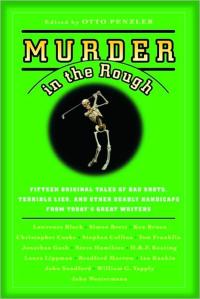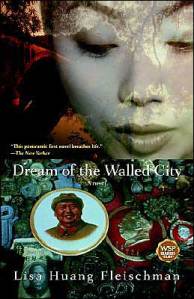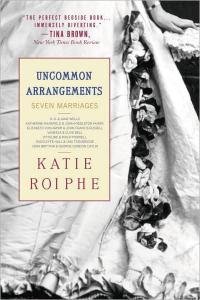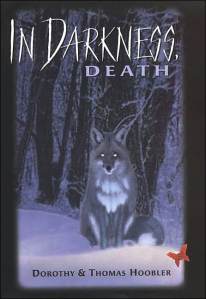A Rule Against Murder, by Louise Penny
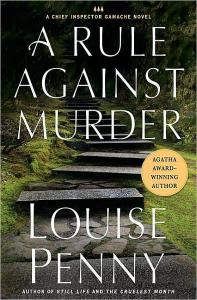 I love the way Louise Penny writes:
I love the way Louise Penny writes:
“Gamache and Reine-Marie looked onto this world of two suns, two skies, of mountains and forests multiplied. The lake wasn’t glass, it was a mirror. A bird gliding across the clear sky appeared on the tranquil water as well. It was a world so perfect it broke into two. Hummingbirds buzzed in the garden and monarch butterflies bobbed from flower to flower. A couple of dragonflies clicked around the dock. Reine-Marie and Gamache were the only people in the world.
This earthly paradise is the Manoir Bellechasse, a lodge in the countryside of Quebec. It is a place frequently visited by Armand Gamache, Chief Inspector of the Surete du Quebec, and his wife Reine-Marie. Here, they find repose amid deep beauty. At least, that is what they usually find, and what they do in fact find, at least initially on this visit, despite the presence of the Morrow clan. The Morrows have come to the Manoir for a reunion, of sorts. I say “of sorts” because we usually think of family reunions as happy occasions, and this one is anything but. The Morrows are a dysfunctional bunch if there ever was one. At first, they are merely cold to one another and condescending to everyone else. Peter Morrow of the Village of Three Pines, an artist already known to the Gamaches, offers this blunt assessment: “‘We’re not a big family for kids….We eat our young.'” His wife Clara, also an artist, whose grim fate it was to marry into this cohort of adversaries, considers the Morrows to be “…Olympian in their ability to avoid unpleasantness, while being very unpleasant themselves.”
In this novel, Penny spends plenty of time setting the scene, and her meticulous attention to detail pays off. Well before the actual crime occurs, the reader feels thoroughly embedded in the situation: we know these characters, both the staff and the guests; we feel the love that the Gamaches have for the Manoir and touchingly, for each other as well.
Eventually a terrible crime does occur, shattering the peace of guests and staff alike and thrusting Gamache back into the role from which he was hoping for an escape, however brief – the role of investigator in a murder inquiry. As a reader, I felt the loss of serenity as keenly as did Armand and Reine-Marie.
Louise Penny is a positive genius at economical description of individuals, both as regards their physical appearance and their personalities. Of Morrow family matriarch Irene Finney:”She looked like a soft, inviting, faded pillow, propped next to a cliff face.”
Of Chef Veronique: “She was huge and beefy, her face like a pumpkin and her voice like a root vegetable. And she had knives. Lots of them. And cleavers and cast-iron pans.”
Here’s an exchange, witnessed by Inspector Jean Guy Beauvoir, between Reine-Marie and Ruth Zardo, a famously malevolent writer who is trailed through the village of Three Pines by a pet duck: “Beauvoir stared at Madame Gamache, as though for the last time. She was about to be devoured by Ruth Zardo, who ground up good people and turned them into poetry.”
Even minor characters are memorably described: “The owner of the crane company was waiting for them at the reception desk. He was small and square and looked like a pedestal. His steel-gray hair was short and stood on end. A red ridge cut across his forehead where a hard hat had sat, that day and every working day for the past thirty years.”
Penny’s powers of observation are formidable. And that’s “formidable,” with the emphasis on the penultimate syllable. The Francophone ambiance of this novel adds greatly to its appeal.
**************************************
I came this series with the first entry:
 Still Life won all kinds of awards and deservedly so. Penny hit the ground running; the marvelous, fully formed world she created in the village of Three Pines in Quebec enchanted readers everywhere. Armand Gamache is an enormously appealing protagonist, and in Still Life, he has to cope with a new young officer whose high opinion of her skills is way out of line with reality. His way of handling that difficult situation shows him to be fair, just, and stern when necessary.
Still Life won all kinds of awards and deservedly so. Penny hit the ground running; the marvelous, fully formed world she created in the village of Three Pines in Quebec enchanted readers everywhere. Armand Gamache is an enormously appealing protagonist, and in Still Life, he has to cope with a new young officer whose high opinion of her skills is way out of line with reality. His way of handling that difficult situation shows him to be fair, just, and stern when necessary.
I confess that when I turned to the sequel, A Fatal Grace, I was disappointed. That novel featured a main character that I found so two-dimensional, stereotypical, and just plain irritating that I was unable to finish the book. The third, The Cruelest Month, I just never got to. But I am so happy about number four, A Rule Against Murder – it is just plain terrific!
Puppy love
No, it’s not my puppy – though I rather wish it were. On Wednesday June 24, in a column in the Washington Post, Michael Gerson declared himself to be in love – with this little guy:
Gerson confesses himself amazed at this turn of events, since, as he states in his opening sentence, he has never liked dogs. Admittedly, for some of us reading this piece, the thought arose at once: What took you so long?
Never mind – better late than never.
“A Latte To Warm the Heart” goes from sentimental to discursive, then back to sentimental at the end. No matter; Gerson could have interpolated a discussion of particle physics for all I care, so completely delighted am I by his conversion to animal lover.
The article concludes with these words from A Christmas Carol by Dickens:
“Many laughed to see this alteration in him, but he let them laugh and little heeded them. . . . His own heart laughed and that was quite enough for him.
So…how long must we wait before introducing Michael Gerson to the likes of:
The Art of the Mystery: July 9, 2009
It has ever been thus with presentations, or deadlines of any kind. You think you have all the time in the world, then you take a good look at the calendar and you realize the date is fast approaching, and you are not quite ready…
Actually, things are coming along nicely with regard to
So far, the book list is long and lovely, and I’ve made some timely revisions to the list of websites. And now I am informed that refreshments will be on offer! So far, so good.
During the run-up to a presentation, the media almost always offers up a nice gift. It happened yet again, in the June 22 Style section of the Washington Post. First off, there’s “Newspaper Noir,” about the problems encountered by Michael Connelly as he strove, in his latest novel, to depict realistically – and accurately – an industry in extreme flux.
Meanwhile, The Scarecrow pushes to the top of the bestseller list, so don’t be too worried about Michael Connelly and his brilliant career! In our crime-fiction -loving community, the library’s lengthy reserve list on this title means a bit of a wait. What to do in the meantime? Read an earlier Connelly – I particularly enjoyed these:
Also, Connelly is the editor of an anthology I mentioned in a previous post:
The final story in this collection, the moving “Father’s Day,” is by Michael Connelly.
Also in this same Style section is a review of Black Water Rising by Attica Locke. This piece, written by the Post’s veteran mystery critic Maureen Corrigan, addresses some interesting questions about plot and character in crime fiction.
Laura Lippman
One of the great things about living in the Columbia/Ellicott City area is the large proportion of residents who count themselves book lovers. My years of work at the library has taught me a deep appreciation of these folks. Even so, I was impressed by the size of the crowd that turned out this past Tuesday night to hear crime novelist Laura Lippman. (Lippman’s appearance was part of the Columbia Festival of the Arts; the evening’s presentation was also the fruit of the Festival’s partnership with HoCo PoLitSo.)
Lippman began by saying that unlike some writers, she doesn’t mind explaining where she gets her ideas. For instance: she described driving with her husband David Simon past Wheaton Plaza – now called Westfield Shoppingtown Mall in Wheaton – in 1985 and recalling the disappearance of the Lyon sisters ten years earlier. For those of us living in the Baltimore/Washington area in the mid-1970’s, this was an unforgettable and deeply disturbing story. On March 25, 1975, Katherine Mary Lyon, age 10, and Sheila Mary Lyon, age 12, walked from their home to Wheaton Mall, a half a mile away. They were seen at the mall; later, they were seen leaving the mall in the direction of home. But they never got home. And they were never seen again. Their disappearance is now a stone cold case.
As Lippman thought back on this story, a question arose in her mind: What if, years after the fact, a woman arrived on the scene claiming to be one of the sisters? Thus was the seed sown for What the Dead Know (2007), winner of numerous awards and one of the most gripping crime novels I have ever read. 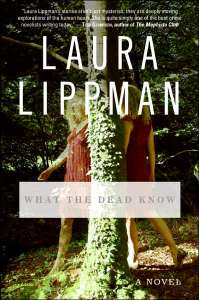
Lippman calls this kind of inspiration a lightning bolt. But a story idea can also come from what she calls an external prompt. This scenario almost always involves a request to contribute to a themed anthology, such as:
She enjoys this challenge; in fact, when it comes down to it, she’s a fan of the short fiction form in general, both as a writer and a reader. Her other favorite literary genre is memoir, and she recently provided the Guardian with a list of ten of her favorites. It seems natural that Lippman would gravitate to the memoir, as one of her chief preoccupations is the nature of memory. She relates with relish an anecdote concerning David Simon’s story about himself as a youngster, a story that he always enjoyed telling. Enjoyed, that is, until a childhood friend informed him that his recollection of an event crucial to the tale was erroneous. The story involved pro baseball, so it could be fact checked. It was fact checked: the friend was right; Simon was wrong.
In this particular instance, no great harm was caused by this corrective action. Nevertheless, it set Lippman to wondering: what would happen if a memory you cherished, one that was integral to your sense of self, was proved wrong? Thus came more grist for the novelist’s mill! (In addition, Lippman was moved to initiate “The Memory Project” on her website.)
 Lippman has been on tour in recent months promoting her latest novel. As with What the Dead Know, Life Sentences had its genesis in a real life incident: in 1988, Jackie Bouknight (pronounced “book night”), an impoverished Baltimore woman, went to jail for refusing to divulge the whereabouts of her infant son Maurice. She was ultimately released in 1995, still declining to provide any information concerning Maurice. Researching this story, Lippman found herself wondering what a seven year silence would feel like. Laughing, she added that she was especially intrigued by this question becasue she herself was such a compulsive talker.
Lippman has been on tour in recent months promoting her latest novel. As with What the Dead Know, Life Sentences had its genesis in a real life incident: in 1988, Jackie Bouknight (pronounced “book night”), an impoverished Baltimore woman, went to jail for refusing to divulge the whereabouts of her infant son Maurice. She was ultimately released in 1995, still declining to provide any information concerning Maurice. Researching this story, Lippman found herself wondering what a seven year silence would feel like. Laughing, she added that she was especially intrigued by this question becasue she herself was such a compulsive talker.
Here’s a write-up by Lesa Holstine of the author’s appearance in April at a library in Glendale, Arizona. In her talk there, Lippman covered much the same ground as she did with Tuesday evening. In fact, I had a feeling at the time that she knew her material more or less by heart. If she consulted notes, I didn’t see her do it. Her presentation had a spontaneous, artless quality that I for one greatly admired. It’s hard to imagine a more engaging speaker, and with a great sense of humor as well.
Here’s a video of a similar talk presented in March at Northeastern University:
Tuesday night, Lippman spoke for about a half an hour; then she took questions from the audience. That, off course, is the part of an event like this that is by definition unscripted. Interesting tidbits often emerge in such a setting, as they did in this particular case:
When asked what her favorite novel was, she replied without hesitation, Lolita by Vladimir Nabokov. In addition, she praised the spoken word version performed by Jeremy Irons. Lippman also mentioned All My Friends Are Going To Be Strangers by Larry McMurtry, whose first line she loves because it is so “authoritative:”
“I think I fell in love with Sally while she was eating breakfast, the first morning we were together.”
An audience member asked whether she enjoys teaching writing, and she responded with enthusiasm, adding that she likes the way in which instructing others in the craft of fiction causes her to ask deeper questions about her own techniques and methods. (This exchange put me in mind of “Show or Tell,” an article in a recent issue of the New Yorker Magazine on the subject of creative writing curricula in colleges and universities.)
I’d like to return for a moment to What the Dead Know. In an interview she gave to the Urbanite, Lippman mentions that she is often asked if she requested permission from the Lyon family to create a fictional treatment of their tragedy. She says she has two answers to that question:
“One is them is about me as a nice person, and one of them is about me as not a nice person. And the first one is that I knew where the family was; I knew how to call them. I didn’t do that because I didn’t see it providing them with any comfort or solace, and I thought I would be intruding on them and I didn’t see that as being a benefit to them.
Secondly, I didn’t ask for their blessing or permission because I didn’t need it. Because I’m a writer, I get to write about what I want to write about and I’m not going to cede any territory as a novelist. I’m not going to ever say, “I’m not allowed to tell this kind of story,” and that’s true across gender lines, across class lines, across racial lines. The only limit is I can’t write about places unless I know them very well.
I don’t know about you, Dear Reader, but I confess to a slight uneasiness about this. I attempted a thought experiment in which I was the bereaved party, and I have to admit, I would be angry if someone made use of my personal Hell for the purpose of entertainment. On the other hand, Lippman’s argument against censoring herself is compelling. Finally, in What the Dead Know, the anguish of the parents is bodied forth so convincingly and with such compassion, it almost seems like a tribute.
The annual parley of the Literary Ladies produces an enticing array of titles
Friday night’s planning session of the Literary Ladies book discussion group produced the inevitable profusion of must-read novels. ( I’m always leery of writing about books that I have not read, so I’ll beg your indulgence to begin with if I get anything wrong here.)
From Marge came these suggestions:
Marge’s description of the plot premise of A Fortunate Age – a group of Oberlin graduates relocate to New York City in order to make their way in the world – put me in mind of Claire Messud’s wonderful novel from 2006, The Emperor’s Children. I also liked the sound of The Laws of Harmony, since it is set in two places of exceptional beauty: New Mexico and the islands of Puget Sound in Washington State (known in these parts as “the other Washington”).
When Marge talked about Sarah’s Key, though, I became somewhat apprehensive. The Holocaust figures in this novel, and that is a subject I find it very difficult to read about. If I am going to read about it, I’d rather do so in nonfiction. I have a problem with the use of that terrible blight on Europe’s history to enhance the seriousness of a fictional narrative – or to provide subject matter for the novelist, to begin with. Marge has not actually read this book yet, but she said that both her husband and her son were deeply moved by it. In fact, she has the same reservations about reading in that subject area that I do. She said she’d report back to us, at the same time making no promise that she’d be able to get through the novel herself.
Teresa’s turn was next. She suggested these:
Then it was Cristina’s turn. It has always seemed to the rest of us that Cristina devours with amazing speed large numbers of new fiction titles as soon as they make it into the library’s collection. She is a voracious as well as a passionate reader and so had plenty of titles to suggest. Here are several:
Though possessed of a ready laugh and a great sense of humor, Cristina tends to favor novels that vary between high seriousness and…well, higher seriousness. Marge, with some degree of desperation (which I confess I shared), asked her if she’d anything recently that the rest of us might consider “light.” She readily proffered  . I’d heard of this slender volume but didn’t know its subject. Here’s a “rapid review” presented by two delightful young Englishwomen:
. I’d heard of this slender volume but didn’t know its subject. Here’s a “rapid review” presented by two delightful young Englishwomen:
An Uncommon Reader looks like so much fun; I am definitely going to read it, especially since I know nothing disturbing happens in it. (The Corgis are just fine, thanks!)
Cynthia suggested these:
 Here is an interview with Toni Morrison in which the Nobel laureate discusses her latest novel with NPR’s Lynn Neary:
Here is an interview with Toni Morrison in which the Nobel laureate discusses her latest novel with NPR’s Lynn Neary:
Emma suggested  . I haven’t so much as set eyes on this book, but I know already that it evokes extreme reactions from readers, who seem to either love it or loathe it. I admit to being put off by the title, which seems to me gimmicky and silly, although I understand that the novel itself is anything but.
. I haven’t so much as set eyes on this book, but I know already that it evokes extreme reactions from readers, who seem to either love it or loathe it. I admit to being put off by the title, which seems to me gimmicky and silly, although I understand that the novel itself is anything but.
So what did Yours Truly bring to the table? I admit – I went with the old, since, with the always-important exception of mysteries, I had read virtually no new fiction in weeks, maybe even months. The group has from time to time asked that I lead them in discussing a classic, so I brought along these:
I’ve led discussions of both for the library, so I know they work well for that purpose.
Lately I’ve been noting how much great reading there is to be had in nonfiction. I brought along two examples to share:
Mary Shelley’s life was almost unbearably sad, starting with the fact that her mother Mary Wollstonecraft, renowned author of On the Vindication of the Rights of Women, died giving birth to her. Yet in between all the terrible tragedies that dogged her life, Shelley produced several distinguished works, with one towering above the rest, at least as far as renown is concerned:
Dorothy and Thomas Hoobler are an interesting, not to mention venturesome, writing team. This is the fruit of their latest collaboration:
They are also the authors of In Darkness, Death. I’m not a great reader of YA literature, but I love historical fiction and I really enjoyed this novel, which is set in 18th century Japan:
As for Katie Roiphe’s Uncommon Arrangements, not only would this be a great discussion book in and of itself, but you could structure an entire seminar around it, since most of the individuals who form Roiphe’s subject here were themselves writers of distinction.
In this elegant video presentation, Roiphe talks about her book and the writers who appear in it:
I was unfamiliar with the majority of books and authors brought to the table Friday night. Some weeks before the Italy trip, I got really turned off on contemporary “literary” fiction (with the exception of certain short story collections). Most of it seemed to me overly earnest, humorless, set in bleak places amid war, famine, and pillage. Either that, or more domestic forms of internecine strife took center stage. Often I found lacking the structural elegance which I consider de rigueur in a good novel (and the best example of which I can think of off the top of my head being Case Histories by Kate Atkinson). On top of all this, the writing was often mediocre.
In recent years, when choosing what to read, I’ve felt a need for the structure and resolution of crime fiction, the wonder and enlightenment of history, and the consolation and encouragement to be had from books like The Reason for God by Timothy Keller. And since returning from Italy, I’ve becoming newly interested in the literature and history of antiquity (about which more in an upcoming post). Fact is, I approached last night’s gathering with some apprehension.
But I left feeling exhilarated. For one thing, I received a much-needed reminder of the necessity of keeping an open mind. And for another, I felt privileged to be among such a great group of book talkers, and book lovers!
At one point in the meeting, this question arose: How much of a book do you read before you decide it is just not working for you? Teresa said that she once she begins a book, she feels obligated to stick with it to the end. Cristina says she allows about one hundred pages before giving up. At that point, Marge and I looked at each other and couldn’t help but laugh. I don’t recall what she said, but I know what I said: “I give it about ten pages!” Yes, I know – what could possibly justify such peremptory judgment? I can only say, in my defense, that I am now 65 years old, and after a lifetime of loving books, at this point, I want to read only what I love.
(Having made this statement, I should also add that I have given up on more novels than I probably should have because I was put off by the way in which they began. Violence – against humans or animals – well, all right, especially against animals – a profusion of characters introduced all at once, a complex/bizarre scenario that I can’t get my mind around – any or all may be enough to make me postpone the effort or give it up altogether. Bottom line for me: reading should not feel like work. Margaret addresses this subject in “Sticking with it,” a post on her blog Booksplease.)
Titles so far definitely selected for upcoming discussions are The Housekeeper and the Professor, A Mercy, and Little Bee. Various other commitments were secured, including mine to lead a discussion on either Brat Farrar or The Professor’s House in December. One of our best discussions in recent years occurred when each of us read a different title by Penelope Lively and then met to discuss her work as a whole. This year we’re going to examine the oeuvre of one of my favorite authors, Anita Brookner. Since several of us recently obtained our reserve copies of Strangers, her first novel to appear in four years, this incomparable chronicler of the vagaries of the human heart naturally came to mind.
These days, our lives are filled with so many distractions, many of them electronic in origin. Don’t get me wrong – I love our TV viewing set-up, fine tuned by Ron, and this wonderful Gateway laptop as well. It’s not the devices themselves; it’s the trivial (and some times pernicious) uses to which they are sometimes put. If there is one thing I have learned from working at the library, it is that the book club members are the ones holding up the banner for the written word. Seeing the Literary Ladies in action, doing just this, filled me with hope and pride.
Sunday Sampler: from newspapers to Naples – again…
Every Sunday morning, I am greeted with one of my favorite sights: The Washington Post and The New York Times lying on my driveway. Now speaking of driveways, ours is about fifty feet long. Over the (more than twenty) years that we’ve lived here, we’ve noted an increasing propensity on the part of delivery people to leave not only newspapers but telephone books (such quaint anachronistic objects) and various other things at the very end of the driveway. (In our house, this is known as the DDS, or Driveway Delivery System.) At the very least, in the case of the newspapers, this means every morning trudging out to the street in my jammies for the purpose of obtaining the paper. (Don’t worry – I usually throw a robe or a raincoat over my rumpled nightclothes.) I have nothing against a good brisk walk, weather permitting. But when it’s pouring down rain, newspaper retrieval becomes a real adventure. The experience is especially exasperating when the paper has taken on water, usually through the process of wicking. (Is “wicking” the result of some law of physics, and if so, can it be repealed?)
This scenario is rendered even more interesting if it is snowing. At such times, Yours Truly, the early riser in the family, can be seen in a housecoat, wool cap, and clunky winter boots, schlepping out to the end of the driveway, in hope of finding the paper, which may be buried in a snow drift. One feels a bit like an archaeologist, unearthing an artifact artfully concealed by Nature…
Yes, I know, in the scheme of things, these are but minor annoyances. But at the very least, you’d think that in this time of hysteria over the possible disappearance of hard copy newspapers , it would occur to circulation departments that people may be canceling because they’re tired of dealing with this recurrent inconvenience. In fact, some papers may finally be seeing the light. For the past several months, the Sunday Times has been landing about two thirds of the way down the driveway. Alas, the Post is still poised at the lip, so not too much joy there after all.
But wait! The good people at the Post have handed us book lovers an unexpected treat today:
 No, your eyes do not deceive you: it’s a separate Book World Section! It is twelve pages in length; in addition, there are two pages of book reviews in the Outlook section. So this is a banner day for the Sunday paper after all.
No, your eyes do not deceive you: it’s a separate Book World Section! It is twelve pages in length; in addition, there are two pages of book reviews in the Outlook section. So this is a banner day for the Sunday paper after all.
Now I want to spotlight two recent articles from the Times. First, last Sunday’s Week in Review had a feature piece on Italian politics entitled “In Italy, Questions Are From Enemies, and That’s That.” Above the text is a picture of Silvio Berlusconi looking for all the world like – well, like someone you would not want to cross:
This article was of interest, naturally, because of my recent sojourn in Italy. But it was also timely because I saw Il Divo at the AFI Silver Theatre in Silver Spring with my erstwhile traveling companions Linda and Jean.
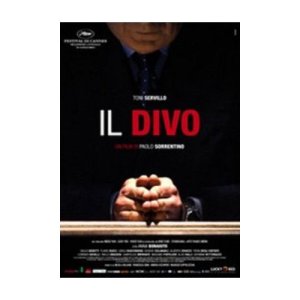 Il Divo is a film about the life and times of Giulio Andreotti, who, in the words of the synopsis on the film’s website, “…has been Italy’s most powerful, feared and enigmatic politician.” All three of us felt that because we lacked a background in contemporary Italian politics, and because of the language barrier, a problem even though there were subtitles, we had trouble at times understanding what was happening on screen. Nevertheless, we got the general drift of this powerful and frightening, if somewhat over long film.
Il Divo is a film about the life and times of Giulio Andreotti, who, in the words of the synopsis on the film’s website, “…has been Italy’s most powerful, feared and enigmatic politician.” All three of us felt that because we lacked a background in contemporary Italian politics, and because of the language barrier, a problem even though there were subtitles, we had trouble at times understanding what was happening on screen. Nevertheless, we got the general drift of this powerful and frightening, if somewhat over long film.
In La Bella Figura: A Field Guide to the Italian Mind, author Beppe Severgnini observes that “Italy is the only workshop in the world that can turn out both Botticellis and Berlusconis.”
Finally, “Deep in the Heart of Historic Naples” appeared in yesterday’s Times. After I read this article, I fired off an impassioned letter to the paper, saying how fascinating I found Naples and how much we missed seeing because we had so little time there. I concluded with by saying, “I’d go back in a heartbeat.” Until the moment I wrote that sentence, I hadn’t admitted to myself that I felt that way.
****************************************************
Here Jordan Lancaster, in her book In the Shadow of Vesuvius, describes the communal worship of the Greek gods in Neapolis. This would have taken place around the fifth century BC:
“Everyone participated enthusiastically and with exuberant gusto in the celebrations. First and foremost wass undoubtedly the cult of the siren, Parthenope. The cult of Aphrodite, the goddess of love, was also strong in Neapolis, as maritime traders and seafarers were particularly devoted to her. Dionysus, the god of wine, and Demeter, the protectress of the harvest, governed the most important local crops in the predominantly agrarian economy. The earth mother and the god of ecstatic liberation embody a seductive, pagan quality that the area has always enjoyed, an alluring combination of beauty and fertility.
Lancaster goes on to quote the Roman historian Livy, who gets even more specific:
“‘To the religious content were added the pleasures of wine and feasting, to attract a greater number. When they were heated with wine and all sense of modesty had been extinguished by the darkness of night and the mingling of men with women and young with old, then debaucheries of every kind began and all had pleasures at hand to satisfy the lust to which they were most inclined.’
An old, old city, with an amazing history…
***************************************************
Here are some more of my photos of Naples:
How to present: The Art of the Mystery
I’ve just started work on preparing for this event, and all I can say at the moment is..Good Grief!! Where to start? What to say, in the space of one hour, about my favorite genre and most beloved form of entertainment, and often – yes, more often than you’d think – edification as well.
I began by sitting down with a legal pad. Somehow, I am always reassured by legal pads: surely I will think of something useful when confronted by those lovely blue lines and equally lovely yellow background… So, at first, naturally, nothing at all came to me. Then I scribbled the following:
1. Quiz?
2. Useful websites, including & especially “Best of” lists
3. Secondary sources and other nonfiction titles of interest
4. History of the genre
5. Classics
6. Good titles for book discussion
7. Subgenres
8. Trends
9. Specific title recommendations
10. General author recommendations
11. Short story recommendations
12. Recommendations from audience members
All in the space of one hour, right? Right….
I think that folks come to this sort of event eager for recommendations. So I consulted my “Best Mysteries” posts for 2007 and 2008 and got some good ideas from those. But this made me think about what my favorite “reads” in crime fiction were for this year. After all, it being June, it’s a reasonable time to take stock. Here are some leading candidates:
But wait – I’d better stop here, as I don’t want to give the game away completely!
I will tell you, though, that the room will be filled with mysteries and some related nonfiction; there will be book lists and other handouts – and maybe even more…
The final obstacle to overcome is the perception some people have that Glenwood is at the farthest edge of the known universe. It’s actually at a lovely location in western Howard County. I get there by going west on Route 144, aka Frederick Road, which winds through some exceptionally pretty countryside. You will probably see horses as you drive along. Sometimes there are even cows and sheep! So treat yourself to this bucolic excursion on July 9. It will culminate in what I trust will be an enjoyable evening for all, as we talk about The Art of the Mystery.
Seeking – and finding? – Wagner’s ghost at Villa Rufolo in Ravello
I bought this book when it first came out ten years ago. It quickly became emblematic of my desire to return to Italy.
Although published by Fodor’s, this is not your standard travel guide. For one thing, the writing (by Robert I.C. Fisher) veers from sardonic to rapturous. And the pictures, also taken by Fisher, are spectacular.
Of course, it helps that the subject happens to be the Amalfi Coast, considered by many to be one of the most beautiful places on Earth. I quoted Gore Vidal to that effect in a recent post. (Vidal lived for many years in Ravello.)
Travel writer Lucia Mauro vividly and poetically evokes the experience of “Seeking Wagner’s Ghost in Ravello.”
And here is Robert I.C. Fisher: “A veil of celestial blue extends as far as you can see when you stand on the upper terrace of the Villa Rufolo. The cerulean hue is not merely a color–it is a miracle, defining ‘blue’ once and for all. ”
Here is that view:
“It’s no small mystery why Landolfo Rufolo, described in Boccaccio’s Decameron as one of Italy’s richest men, chose this matchless mountain perch for the site of his 13th century estate. A Scheherazadian extravaganza of Norman batttlements and terraced gardens, with an Arab-Sicilian cloister, his villa was designed to welcome Moorish emirs and French kings. But it found its immortality centuries later when Richard Wagner unexpectedly arrived at its gates in February 1880 and stayed the night, banging out the second act of Parsifal on an untuned piano, accompanied only by his giant ego and a fierce thunderstorm. “Klingsor‘s garden is found once again!” the great 19th century composer crowed of the wizard who ordered the seduction of the opera’s saintly hero.
Before I left for Italy, I wrote about my sense of mission with regard to the Villa Rufolo. So, when I found myself actually there, I was already primed for an extraordinary experience. I had seen pictures and done a fair amount of reading, always with my Wagner-loving brother in mind. And as luck would have it, I had discovered that we had a Wagnerite in our group: Christine, an exuberant, adventurous person and a passionate opera lover, was traveling with her sister Judey.
As we entered the grounds of the Villa, one of the first things we saw was this plaque:
Cameras were held aloft, shutters clicked repeatedly. Christine cried out, “Roberta, this is our moment!” She was right.
But it was only the beginning…
Accompanying all this loveliness was the occasional faint sound of musical instruments. Villa Rufolo plays host to Chamber Music on the Amalfi Coast, a music festival that runs from March to July, and again from September to November. What we were hearing was the musicians practicing. Our guide told us that when the stage is set up, it looks as though it is suspended over the water.
Our precious time at the villa was drawing to a close. I wished we could stay longer. I was expressing this wistful sentiment to one of my fellow tour members when I heard the clarion call of the trumpets from the Prelude to Parsifal. It came crisp and clear, much more immediate than the snatches of music I’d been hearing up until that moment.I broke off, exclaiming. “Oh my God – Parsifal!” I don’t what became of my interlocutor; I just knew I had to find those brass players. Following the already-dying strains of the Prelude, I found a small room with no door, that opened onto a remote part of the garden. The room was empty, save for a television that was the source of the music. The Prelude faded away; it was followed by pleasant, albeit mundane video of people coming and going along a street in a village. The music became soft, unexceptional pop tunes. There was voice over narration, in Italian.
I turned and left, not sure what had just happened. Christine and I, alas, had gone our separate ways. I regretted that she had not been there to share this moment with me as well.
***************************************************
Later, when we went to visit the shops in Ravello’s piazza, we discovered that the name “Klingsor” had taken on a life of its own in the world of local commerce!
******************************************************
Here is an excerpt from the Good Friday Spell.Wilhelm Furtwangler conducts the Berlin Philharmonic in this historic performance:
Lawrence Block, sympathetic villains, and Great Books Lists
In one of my posts on favorite mysteries of 2008, I mentioned Lawrence Block’s new series, Keller’s Greatest Hits. I had listened to Hit Parade, read by the author, and found it extremely entertaining. In fact, it was one of the titles I chose to book talk this past Tuesday night at the “Great Summer Reads” panel.
This event, by the way, was well attended and enjoyed by all, including – perhaps especially! – the panelists themselves. Once again, I could only marvel at the skill of the book talkers of Howard County Library. Jean, Joanne, Beth, and Aimee were eloquent and impassioned, and their recommendations were varied and intriguing. Here are just a few that made it onto my own to-read (or listen- to) list:
Like the other presenters, I had just enough time to talk about my own “top five.” Here’s my complete list:
FIRST GROUP- I planned to discuss these five:
THE GARDNER HEIST – Ulrich Boser
IN DEFENSE OF FOOD – Michael Pollan
ABOUT FACE – Donna Leon
HIT PARADE – Lawrence Block
A NORTHERN CLEMENCY – Philip Hensher
*******************
SECOND GROUP – To be discussed if time permitted, which it didn’t:
CARAVAGGIO’S ANGEL – Ruth Brandon
MRS ASTOR REGRETS – Meryl Gordon
THE BIRTHDAY PRESENT – Barbara Vine/Ruth Rendell
THE GRAVING DOCK – Gabriel Cohen
BLACK SECONDS – Karin Fossum
THE DEMON OF DAKAR – Kjell Eriksson
THE SHOOTING PARTY – Isabel Colgate
THE HOUSE ON FORTUNE STREET – Margot Livesey
BLUE HEAVEN – C.J. Box
(These have all been reviewed by me on this blog. Scroll down to find the search box on the right and type in the title.)
I deliberately saved Hit Parade for last. As I was waxing enthusiastic about Block’s new Keller series, I could feel a distinct chill descend on the room – the first and only time I had noticed such a thing happening. As the evening drew to a close , an audience member came up to me and expressed his reservations regarding the premise of Block’s novel: he was afraid some malefactor would use it as a manual for how to do away with people for profit.
Well. For a minute or two, I was speechless. The best spur of the moment response I could muster – finally – was that Block was playing this premise strictly for laughs, and was in it for chiefly the fun of being deliciously subversive. I added that most of the scenarios he invents fall somewhere between highly unlikely and downright impossible. I sensed that my questioner was somewhat reassured, but not still entirely at ease in his mind. So I suggested what I thought was the most reasonable course of action: Read the book, and make up your own mind.
And thus the evening concluded.
But there is more…
As I was working on this post, I began casting about in my memory for examples of fictional protagonists who might, in some particulars, resemble John Paul Keller. I was looking, in other words, for sympathetic villains. Two examples came to mind immediately: Satan in Milton’s Paradise Lost – “Better to reign in Hell than serve in Heaven” – and Burke Devore in The Ax, by the late, great Donald Westlake.  (This novel has been in the news recently, a propos the current downturn in employment.)
(This novel has been in the news recently, a propos the current downturn in employment.)
Then I came across this rather interesting thread on the subject of sympathetic villains. Ultimately, though, I felt frustrated, because I felt that what I really needed was a large list of titles with which to jog my memory. And the first such list I managed to retrieve had me banging my forehead in amazement – of course! How could I have forgotten:
 Humbert Humbert was one of the most reviled literary creations of the twentieth century, and there’s no doubt about it: it’s unnerving to find yourself laughing out loud while a reading about the exploits of a pedophile…
Humbert Humbert was one of the most reviled literary creations of the twentieth century, and there’s no doubt about it: it’s unnerving to find yourself laughing out loud while a reading about the exploits of a pedophile…
There are still those who find this novel revolting; they are, of course, entitled to their views. But I think it can be agreed that Nabokov was in no way advocating for an appalling type of behavior, any more than Lawrence Block is offering vocational guidance in the Keller’s Greatest Hits series. Both, I think, are being deliberately perverse and subversive, pushing the outer envelope of what’s acceptable in the realm of fiction while at the same time gaining secret (or not so secret) satisfaction by stoking the fires of controversy. (Here’s the Wikipedia entry on the publication history of Lolita.)
Lawrence Block, though a veteran and highly respected crime writer, does not have anything like the high profile enjoyed by Vladimir Nabokov at the time of the Lolita dustup. Still, the (admittedly minor) incident at the panel discussion did get me thinking about the question of literature and responsibility. It’s a big question, one that has no doubt been examined at length by others. Meanwhile, here are two videos of Lawrence Block in which he explains, in an admirably forthright manner I think, the genesis of the Keller character. The first one takes place at a reading and book signing at the legendary Greenwich Village Mystery Bookstore, Partners and Crime.
********************************************************
Lest I forget – again! – Great Books Lists is an outstanding source for lists of classics and contemporary works, fiction and nonfiction – just about everything relating to books and excellence. We owe a debt of gratitude to Robert Teeter, a librarian in a California water agency, who maintains this site.
********************************************************

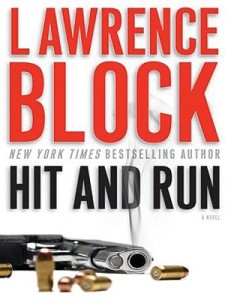 Finally, one last word concerning Keller’s Greatest Hits. I just finished listening to Hit and Run, the fourth and latest entry in this series. Something utterly unprecedented happens to Keller right at the outset, and he finds himself suddenly on the run – desperate, penniless, out of options and almost out of hope. Then he saves someone’s life, at some peril to himself, and his own life takes yet another wholly unexpected turn. I have to admit, I am on tenterhooks waiting to see what is going to happen next to this man. And yes – I really am rooting for him.
Finally, one last word concerning Keller’s Greatest Hits. I just finished listening to Hit and Run, the fourth and latest entry in this series. Something utterly unprecedented happens to Keller right at the outset, and he finds himself suddenly on the run – desperate, penniless, out of options and almost out of hope. Then he saves someone’s life, at some peril to himself, and his own life takes yet another wholly unexpected turn. I have to admit, I am on tenterhooks waiting to see what is going to happen next to this man. And yes – I really am rooting for him.

 I guess I’ll have to accept the fact that the Keller novels are not for everyone. I’m put in mind of my relentless espousal of The Horned Man by James Lasdun. This was a book that no one seemed to like but me! Ah well – I also liked Seven Lies by this author, though it didn’t have quite the impact on me that the earlier title did. Lasdun has a short story collection coming out shortly; I am most eager to get my hands on it. In his ability to get deep inside a disturbed and seething mind and then write about it with complete conviction, Lasdun puts me in mind of the great Ruth Rendell.
I guess I’ll have to accept the fact that the Keller novels are not for everyone. I’m put in mind of my relentless espousal of The Horned Man by James Lasdun. This was a book that no one seemed to like but me! Ah well – I also liked Seven Lies by this author, though it didn’t have quite the impact on me that the earlier title did. Lasdun has a short story collection coming out shortly; I am most eager to get my hands on it. In his ability to get deep inside a disturbed and seething mind and then write about it with complete conviction, Lasdun puts me in mind of the great Ruth Rendell.













